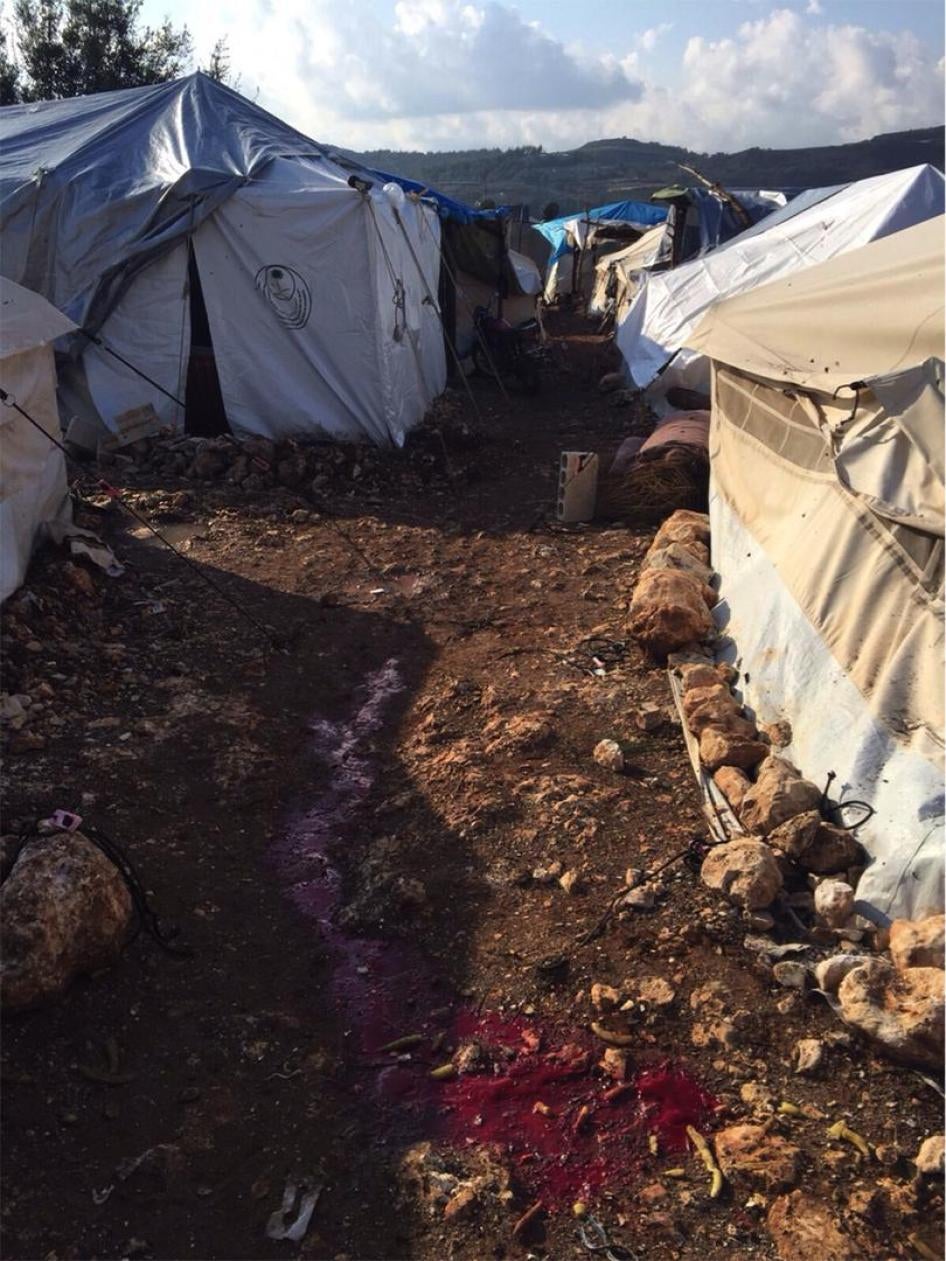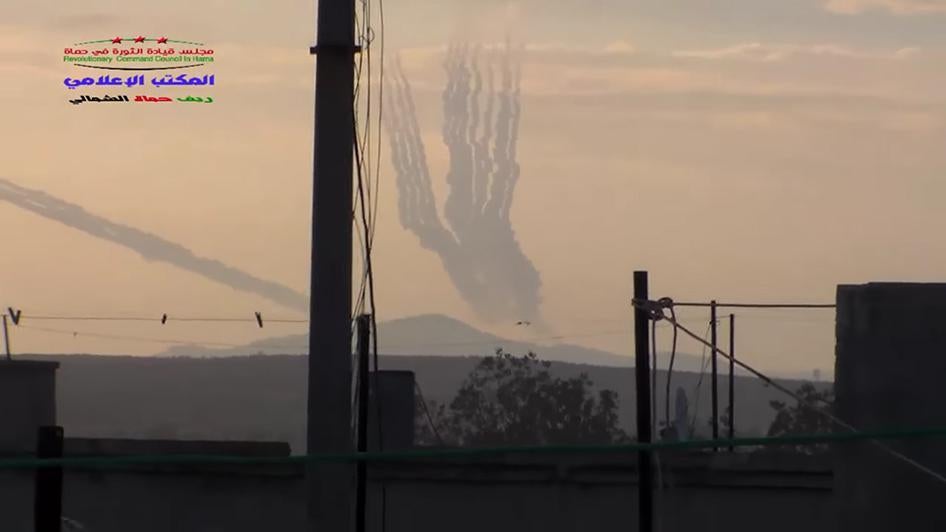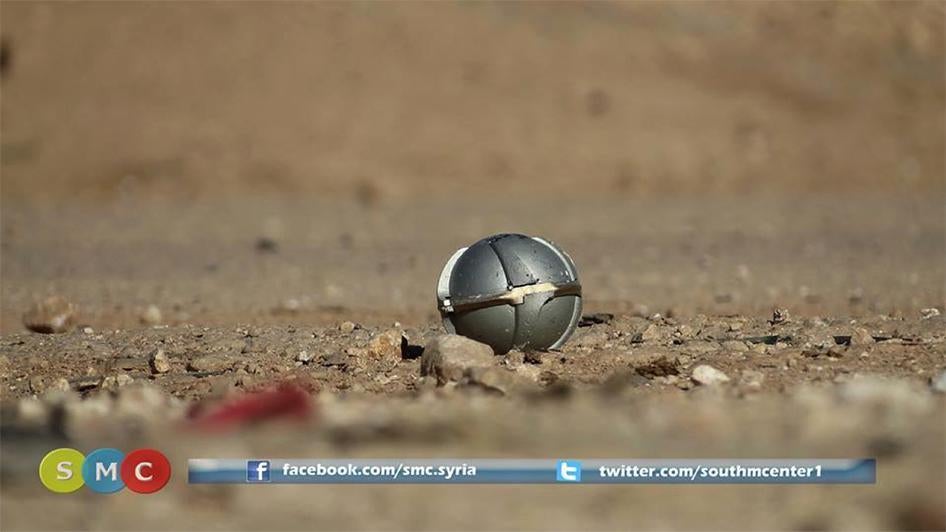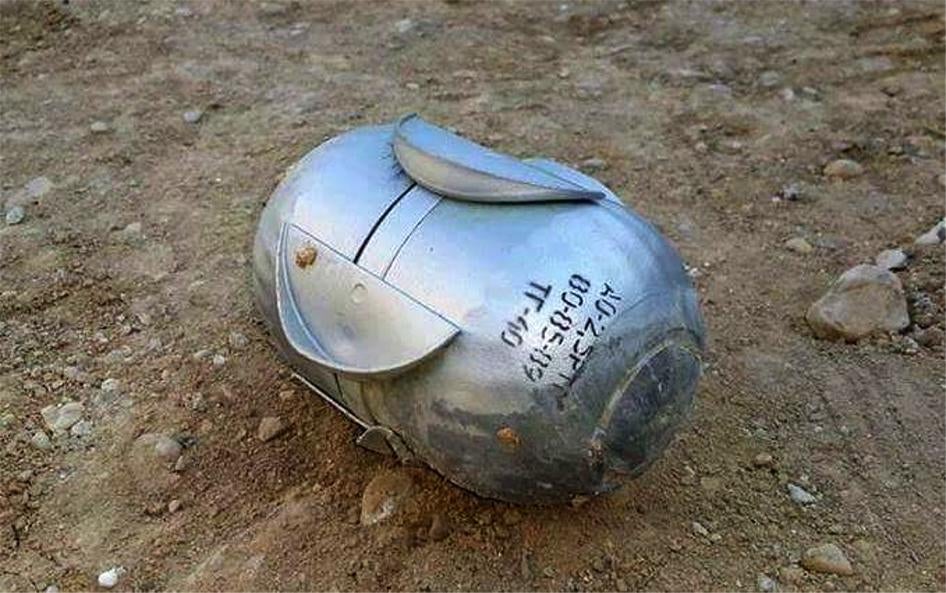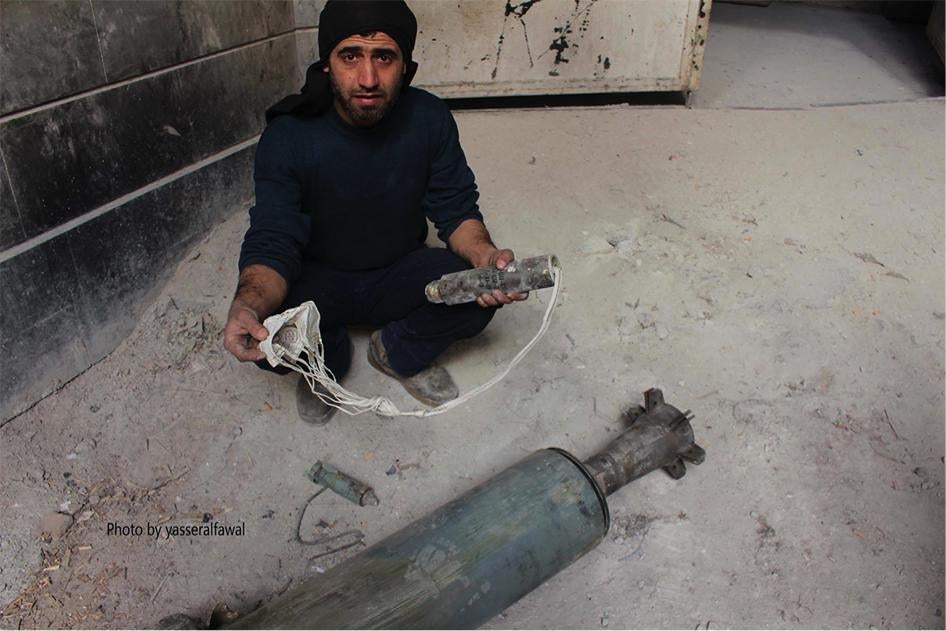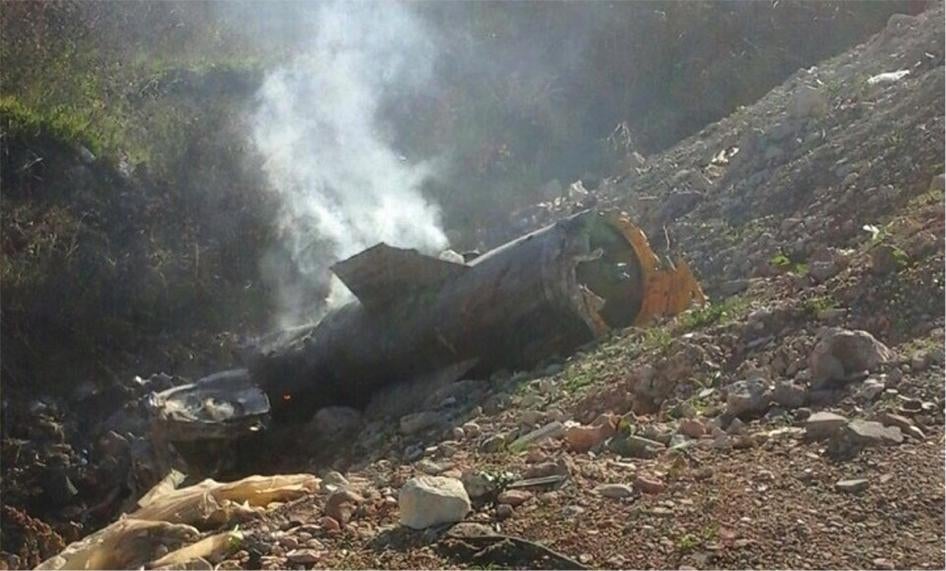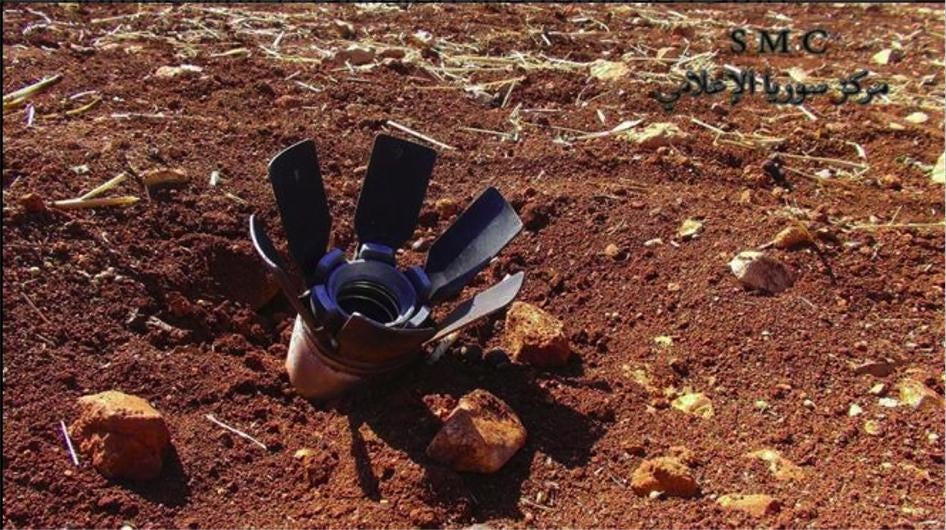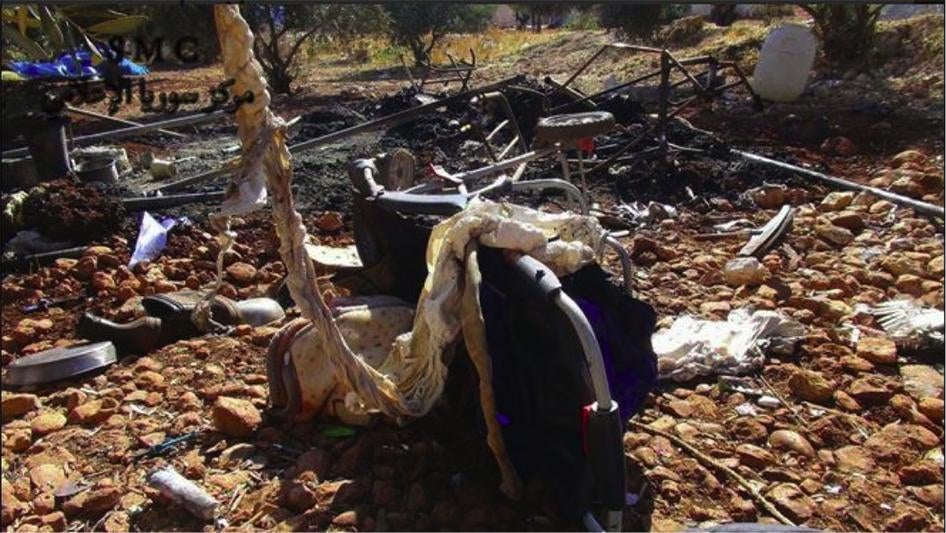(New York) – The military offensive that the Russian and Syrian government forces opened against armed groups opposed to the government on September 30, 2015, has included extensive use of cluster munitions – inherently indiscriminate and internationally banned weapons.
The use violates United Nations resolution 2139 of February 22, 2014, which demanded that all parties involved in Syria end “indiscriminate employment of weapons in populated areas,” Human Rights Watch said. It also contradicts a statement issued by the Syrian Ministry of Foreign Affairs and Expatriates on November 9, 2015, in which it insisted that the Syrian Arab Armed Forces do not and will not use indiscriminate weapons.
“Syria’s promises on indiscriminate weapons ring hollow when cluster munitions keep hitting civilians in many parts of the country,” said Ole Solvang, deputy emergencies director. “The UN Security Council should get serious about its commitment to protect Syria’s civilians by publicly demanding that all sides stop the use of cluster munitions.”
Human Rights Watch documented that cluster munitions were used on at least 20 occasions since Syria and Russia began their joint offensive on September 30. Human Rights Watch collected detailed information about attacks in nine locations that have killed at least 35 civilians, including five women and 17 children, and injured dozens. Two attacks hit camps for the displaced. For the other attacks, Human Rights Watch obtained visual confirmation of the cluster munition used and a second source confirmed the attack. The cluster munitions used in Syria recently that Human Rights Watch was able to confirm were manufactured in the former Soviet Union or Russia.
On the same day that Syrian authorities promised to not use indiscriminate weapons, cluster munitions fell on a camp for internally displaced people in Younseyeh, a village in Idlib province, near the Turkish border. Hospital staff reported that the attack killed seven civilians and injured dozens.
“All of a sudden we heard rockets whistling and explosions all around us,” a visitor to the camp told Human Rights Watch. “I just looked around me in shock and couldn’t feel anything. I had to grab my arm because it was broken and swinging widely.”
Human Rights Watch has documented that several cluster munition attacks in populated areas occurred since then, including an attack that hit two operational schools in Douma, a suburb of Damascus, which killed at least eight children.
The Syrian authorities have not made their November 9 statement denying use of indiscriminate weapons public, but the November monthly implementation report on resolution 2139 includes a reference to it (in paragraph 3).
Cluster munitions are explosive weapons that can be delivered from the ground by artillery and rockets, or dropped from aircraft. A total of 118 countries have banned cluster munitions due to the harm caused at the time of attack and because their submunitions often fail to explode and threaten civilians and military alike, until cleared and destroyed. Human Rights Watch urges Syria and Russia to join the Convention on Cluster Munitions.
Through a review of photographs and videos posted online, as well as interviews with local residents, Human Rights Watch identified seven types of air-dropped and ground-launched cluster munitions recently used in the northern Syrian provinces of Aleppo, Hama, and Idlib.
Human Rights Watch has determined that Russian or Syrian forces were responsible for the attacks. Armed opposition groups do not operate aircraft, which means that Russian or Syrian government forces were responsible for the air-dropped cluster munitions. The four types of ground-fired cluster munitions used recently were launched from large vehicles that are complicated to operate and have never been seen in the possession of armed opposition groups. For several attacks using the 9M55K cluster munition rocket, geo-located video footage shows that the rockets were fired from the base of the Zeyn al-Abedeen mountain, just north of Hama city, in an area controlled by the Syrian military.
All the recent cluster munition attacks documented by Human Rights Watch fell on opposition-controlled territory.
Human Rights Watch has not been able to determine whether Russian or Syrian forces were responsible in individual cases, as they use many of the same weapons and frequently conduct their operations jointly.
The appearance of cluster munitions produced more recently than the ones used before the Russian air campaign began – including two that have not been documented in use in Syria before – combined with recent extensive cluster munition use, suggest that either Russian aircraft dropped them or Russian authorities recently provided the Syrian government with more cluster munitions, or both, Human Rights Watch said.
More than 140 countries have condemned the use of cluster munitions in Syria in UN General Assembly resolutions and statements. This includes the United States and dozens of countries that are not parties to the international treaty, which comprehensively prohibits cluster munitions and requires their clearance and assistance to victims. At the First Review Conference of the Convention on Cluster Munitions in September 2015, states issued a declaration that condemned any use of cluster munitions by any actor.
Russia has not commented on reports by Human Rights Watch and others that it has used cluster munitions in its Syria operation or transferred new cluster munitions to the Syrian government, but on December 7, Russia voted against the first resolution by the UN General Assembly in support of the Convention on Cluster Munitions. The resolution was adopted 139 to 2 (Russia and Zimbabwe), with 40 abstentions.
Human Rights Watch is a co-founder of the Cluster Munition Coalition and serves as its chair. On October 1, the global campaign warned Russia against using any cluster munitions in Syria due to the “foreseeable and preventable” danger posed to civilians.
“Civilians are paying the price of the Syrian-Russian offensive’s use of cluster munitions, with their lives and limbs,” Solvang said. “These weapons should never be used under any circumstances.”
The cluster munition attacks and weapons used
The cluster munition attacks Human Rights Watch recorded include only cases in which videos contained visual confirmation that cluster munitions were used and for which at least one other source confirmed the use of cluster munitions. The actual number of attacks is probably much higher, as local activists reported many more incidents of what appear to be cluster munition use.
Human Rights Watch has documented the use of seven types of cluster munitions in Syria since September 30, 2015, as detailed in the following table:
|
Delivery method |
Carrier type |
Submunition type |
Number of submunitions per carrier |
Number of attacks documented |
|
Ground-launched |
9M27K/9M27K1 rocket (BM-27 Uragan) |
9N210/9N235 |
30 |
1 |
|
Ground-launched |
9M55K rocket (BM-30 Smerch) |
9N235 |
72 |
2 |
|
Ground-launched |
3O8 projectile |
O-10 |
14 |
1 |
|
Ground-launched |
9M79-series Tochka ballistic missile |
9N24 |
50 |
2 |
|
Air-dropped |
RBK-500 bomb |
AO-2.5 RT/RTM |
108 |
10 |
|
Air-dropped |
RBK-500 bomb |
ShOAB-0.5 |
565 |
2 |
|
Air-dropped |
RBK-500 bomb |
SPBE |
15 |
2 |
Syrian government forces have used cluster munitions in multiple locations across 10 governorates of the country since mid-2012.
Human Rights Watch and others have identified two types of cluster munitions that had not been documented as used in Syria prior to the start of Russia’s and Syria’s joint offensive on September 30, 2015. One is the air-dropped Russian-produced RBK-500 SPBE cluster bomb, containing SPBE sensor-fuzed submunitions. This submunition descends by parachute and is designed to destroy vehicles by firing an explosively formed slug of molten metal downward after the vehicle is detected by a targeting system. The other is the ground-launched 240mm 3O8 projectile containing O-10 submunitions, which is used by the self-propelled 2S4 Tyulpan or towed M-240 mortar systems.
Several cluster munitions used since September 30 bear production markings showing that they were produced from 1989 into the early 1990s. (See, for example, the article by the Armament Research Services). This appears to be a noticeable shift from before the Russian intervention, when markings on cluster munitions used in Syria and seen by Human Rights Watch show they were produced in the 1970s and 1980s.
While a number of attacks appear to have hit populated areas such as camps for the internally displaced, other cluster munition attacks documented by Human Rights Watch appear to have struck at or near areas with armed groups or active fighting where there were few – if any – civilians left. However, even in such areas, cluster munitions should not be used in any circumstances because of the danger that unexploded submunitions pose to civilians after the fighting ends, Human Rights Watch said.
Human Rights Watch has also seen recent videos and photographs of three types of submunitions not listed above, but has not been able to confirm their use or who used them. After a cluster munition attack on Douma on December 13, one photograph included a Soviet-era AO-1SCh submunition. The two others are dual-purpose improved conventional cluster munitions (DPICM) that were seen in other parts of Syria, one likely delivered by an Egyptian-made 122mm SAKR surface-launched rocket. The method of delivery and country of manufacture of the second, which has the designation ZP-39, are not known given publicly available information. Human Rights Watch has previously documented the use of all three of these cluster munitions in Syria – the ZP-39 DPCIM submunitions likely by Islamic State (IS) forces in northern Syria in the second half of 2014.
Incidents documented in detail
Due to the prevailing security situation, Human Rights Watch was not able to examine impact sites and remnants directly. To confirm the use of cluster munitions in the villages noted below, researchers interviewed witnesses in person in Turkey, or by phone, and examined photographs and videos taken by various sources.
The cases included in the table at the end are those for which Human Rights Watch both reviewed visual confirmation (video or photographs) of the type of cluster munition and for which at least one other source confirmed the use of cluster munition. Local activists have reported dozens of other cluster munition attacks not included in this report for lack of corroborating information.
In a report on airstrikes in Syria in October 2015, the Violations Documentation Center (VDC), a Syrian monitoring group, described in detail six cluster munition attacks since September 30.
Douma, Damascus, December 13 and 14, 2015
Cluster munitions fell on Douma, an opposition-controlled suburb of Damascus, at least on December 13 and 14, 2015, according to interviews with local residents, first responders, opposition-affiliated activists, and video footage and photographs reviewed by Human Rights Watch.
Three local residents Human Rights Watch interviewed gave descriptions of attacks in the morning of December 13 that are consistent with a cluster munition attack. A media activist and photographer told Human Rights Watch:
It has been two months since they started using cluster munitions, but it is hard to document. The cluster munitions don’t cause significant damage to buildings and they explode, so there are few remnants left. But we know the sound. There is a loud explosion in the sky and after 20 seconds or less, you hear a succession of small explosions, like gunfire but louder. This is how we recognize it.
The attacks on Douma on December 13, which included other weapons as well, killed at least 45 civilians, according to a staff member at the Unified Medical Office for Douma. At least some of the victims appeared to have been killed by cluster munitions, according to local residents that Human Rights Watch interviewed.
Mansour, a member of the Syria Civil Defense, a local volunteer search and rescue organization, arrived at their rescue center shortly after the first cluster munition attack. He said:
There were many killed. I saw 10 to 15 killed, one of them was a child. I saw a woman who was veiled crying next to a child in a white shroud. He was her only child. He was killed when a cluster bomb exploded. She was on her way to pick him up at the school, while a cluster bomb fell and he died. I was so moved by this, she was saying her goodbyes to him.
Some of the cluster munitions fell on two schools in the center of Douma, killing eight children and two teachers, according to those interviewed, photographs, and video.
On December 14, the opposition-affiliated Directorate of Education in Damascus countryside, based in Douma, posted on their Facebook page the names of eight children who had been killed in the December 13 attack. The group also posted photographs and video footage of injured children and damage consistent with a cluster munition strike to what appears to be a school.
A photographer named Sameer al-Doumy, who lives close to the schools, confirmed that the school had come under attack and provided Human Rights Watch with photographs of the damage to the school that he had taken, which show damage consistent with that of a cluster munition attack.
A local journalist known as Yasser al Doumani told Human Rights Watch that he found remnants of the weapon that was used in the school. He filmed them and posted the footage to YouTube.
All those interviewed said that the school was being used as a school when it was attacked and that there were no fighters there.
Armament Research Services identified some of the remnants in al Doumani’s video as belonging to a Soviet-era 240mm 3O8 cluster munition projectile containing O-10 submunitions. This is the first time that this weapon has been documented in Syria.
Local residents said that this weapon had been used repeatedly in Douma in the past two months, providing descriptions of attacks consistent with cluster munition attacks. Human Rights Watch has seen numerous photos of remnants of 3O8 cluster munitions in the past week but was only able obtain visual confirmation of the submunitions on December 13. The remnants, combined with multiple reports of cluster munition attacks suggest, however, that cluster munitions have been used repeatedly in Douma.
Al Doumani’s video also includes an unexploded AO-1SCh submunition, but Human Rights Watch has not been able to determine if it is from a recent attack.
On December 14, cluster munitions again fell on Douma, this time air-dropped. A media activist, who lives 150 meters from the impact location and went there after the attack, told Human Rights Watch that the attack struck a residential area in southwest Douma, which also serves as a medical point for civilians. “When we arrived we saw blood, damages, we found unexploded small bombs, like small balls, some unexploded, some opened,” he said. The activist provided Human Rights Watch with several photos of unexploded AO-2.5RTM submunitions, which he said he took after the December 14 attack.
The activist said that five civilians died in the December 14 attack, but Human Rights Watch was not able to independently confirm this.
Ma`arat al-Nu`man, Idlib province, December 14
Cluster munitions fell on Ma`arat al-Nu`man in Idlib province on December 14, killing at least four civilians, including a 10-year-old girl, according to local media activists and photographs reviewed by Human Rights Watch.
Mustafa Gharib, an opposition-affiliated media activist, told Human Rights Watch that aircraft dropped four cluster bombs on the town around 11:40 a.m. on December 14. He said:
They fell in three different neighborhoods where people were just going about their business buying falafel and walking about. There were no fighters or even headquarters or military targets in the area the bombs fell. People are now starting to comb their homes and gardens and backyards to look for the cluster munitions because there are so many all over the town.
The activist provided Human Rights Watch with the names of four killed in the attack: three men that he described as civilians and a 10-year-old girl. He said that 10 civilians were injured.
Bilal Omran, another media activist, provided a similar account of the attack.
Gharib shared with Human Rights Watch several photographs that he took of unexploded AO-2.5RTM submunitions and of the remnant of an RBK-500 AO-2.5RTM cluster bomb.
Marjeh district, Aleppo city, December 14
Air-dropped cluster munitions fell on the Marjeh district in Aleppo city on December 14, according to a first responder and video footage and photographs reviewed by Human Rights Watch.
A member of the Syria Civil Defense who arrived at the scene a few minutes after the attack told Human Rights Watch that the attack struck a fuel market near a mosque around 10:45 a.m. He said the attack killed three civilians – all men – and injured six people.
He shared several photographs with Human Rights Watch that he had taken at the impact location. The photographs show the remnants of an RBK-500 AO-2.5RT cluster bomb and an unexploded AO-2.5 RT. One video posted on YouTube shows a group of people collecting several unexploded submunitions – one of which they dismantled – and blood in the street. Another video, posted by the Syria Civil Defense, also shows several unexploded submunitions and blood in the street.
Al-Najeya, Idlib province, December 3
Ballistic missiles equipped with cluster munition warheads were used in at least one attack on the town of Al-Najeya in Idlib province on December 3, killing at least one civilian, according to local residents and video and photographs Human Rights Watch reviewed.
A lawyer in Al-Najeya said he saw several puffs in the air and heard many small explosions around 1 or 2 p.m. on December 3. The bombs fell in farms and on houses in the town, he said.
An opposition-affiliated activist in al-Najeya gave a similar account. He provided the name of a civilian who died in the attack and said that three civilians were injured. Two other civilians were killed in an airstrike around the same time, according to an opposition-affiliated activist.
Human Rights Watch reviewed several videos and photos from Al-Najeya showing the remnants of a 9M79-series Tochka ballistic missile, the same type of weapon that struck the IDP camp in Younseyeh on November 9. The footage shows the remnants of at least two missiles.
Human Rights Watch has not been able to establish the warhead carried by the missile, but descriptions of the attack by local residents are consistent with a cluster munition attack.
The activist provided Human Rights Watch with the names of four killed in the attack: three men that he described as civilians and a 10-year-old girl. He said that 10 civilians were injured.
Kniddah, Idlib province, November 13
Ground-fired cluster munitions were used in attacks on Kniddah, a village about five kilometers from the Turkish border in Idlib province, on at least two occasions in November, injuring five civilians, according to local residents and photographs and video Human Rights Watch reviewed.
Munir Haj of the opposition-affiliated Kniddah Media Center said that many people displaced by the war had sought refuge in Kniddah, so it was full of civilians when the first attack occurred on November 13. He said the attack took place around 10 a.m.:
I heard so many explosions. It was loud and frightening. People started running chaotically everywhere trying to find some place to hide, but it was hard because no one knew where the rockets would land.
Abu Shadi, a local resident, said that he was at a shop near his home on November 13 when he heard an explosion in the air, followed by many small explosions that “sounded like rain falling.” Running home, he met his wife, who was carrying their 4-year-old son, seriously injured with a stomach wound. Apparently, Abu Shadi said, his son had tried to run to a shelter on the other side of the road from their house but was injured by an explosion before he reached it. The boy had emergency surgery at a local field hospital and was then transferred to a hospital in Turkey, where doctors had to remove a large section of his intestines because of the injury.
Haj said that five civilians – children ages 2 and 4, two women, and a man – were injured in the attack. A similar attack on November 19 did not injure anybody, he said, partly because most civilians had left the village by then.
Two local residents who recently fled to Turkey confirmed the November 13 attacks and said that a similar attack had struck the village on December 4. (They were not in the village on November 19.) The couple said that some young men from the village belonged to armed opposition groups and sometimes were in the village with light weapons, but that there were no other military targets there.
Haj shared with Human Rights Watch photos of the tail and cargo sections of a cluster munition rocket and two photos of an unexploded submunition. A member of the nearby Bdama Syrian Civil Defense also shared photos of a submunition that had malfunctioned. From the photos, Human Rights Watch identified the weapon used as 9M27K-series surface-to-surface 220mm cluster munition rockets containing either 9N210 or 9N235 submunitions. The 9M27K rocket is launched from the BM-27 Uragan (hurricane in Russian), a similar system to the BM-30 (see below). A video of the attack, also shared by Haj, shows numerous small explosions consistent with a cluster munition attack.
Camp for internally displaced, Younsyeh village, Idlib province, November 9
Cluster munitions were used in an attack that struck near a camp for internally displaced in the village of Younsyeh, close to the Turkish border in Idlib province, on November 9, killing seven civilians and injuring 43, according to a camp manager, a local resident, medical staff, and photographs and video footage Human Rights Watch reviewed.
Abdel Jabar Khalil, the manager of the camp, known as Obien, said that an attack struck the northeastern part of the camp at about 3 p.m.:
We heard loud explosions and so many of them at the same time. There was chaos and total fear and people began to leave the tents and run out of the camp and toward anywhere they thought was safer.
Rashid Silo, 70, who was visiting his family in the camp at the time of the attack, said:
I had only been there for 10 minutes when all of a sudden we heard rockets whistling and explosions all around us. People started running and screaming. I just looked around me in shock and couldn’t feel anything. I had to grab my arm because it was broken and swinging widely. I also got shrapnel wounds in my stomach and back.
Mustafa Yousef, administrator at the nearby Yamadeyah hospital, said that seven civilians, including five children, died in the attack. Five died immediately, while two died in the hospital from injuries sustained during the attack. Yousef said that they received 43 injured, including lost limbs and significant fragmentation wounds. The hospital had to send at least 13 people to Turkey because it was already working at full capacity.
The Syrian Civil Defense shared video and photographs with Human Rights Watch that show the remnants of a 9M79-series Tochka ballistic missile. Human Rights Watch was not able to determine what type of warhead the missile carried, but local residents’ description of the attack is consistent with a cluster munition attack. The Tochka missile can be equipped with a warhead containing 50 explosive submunitions, called 9N24.
Hayyan, Aleppo province, October 22 and 24
At least two types of airdropped cluster munitions were used in attacks on the town of Hayyan and its surroundings on October 22 and 24, killing at least one civilian and injuring 10, according to a local first responder and photographs and video footage Human Rights Watch reviewed.
Abu Nidal, a member of the Syrian Civil Defense, said that cluster munitions were used in an aerial attack around 2 a.m. on October 22. The cluster munitions fell in a residential area north of the town, injuring three civilians: two women and one child. Abu Nidal said that the submunitions had descended with a parachute and that there were about 12 submunitions in each bomb. Abu Nidal dismantled six of the submunitions, he said.
Human Rights Watch identified the cluster munitions as RBK-500 SPBE cluster bombs with SPBE sensor fuzed submunitions, based on photographs published in the VDC report.
Abu Nidal said that cluster munitions were again used, this time in the center of the town, between 9 p.m. and 10 p.m. on October 24. First, there was a huge explosion, he said. Then cluster munitions fell over the same area. Abu Nidal same that some of the cluster munitions were similar to those used on October 22, but that others were of a different type, “the size of your hand,” he said.
Human Rights Watch identified the cluster munitions as an RBK-500 AO-2.5RT cluster bomb with AO-2.5RT submunitions.
“These explode if you touch them,” Abu Nidal said. One of them exploded as he was trying to dismantle it, injuring his leg, he said.
The October 24 cluster munition attack killed two and injured seven, Abu Nidal said. The VDC report contains the name and photograph of one of the dead.
Camp for internally displaced, Al-Naqeer, Idlib province, October 9
Shortly after midnight on October 9, ground-fired cluster munitions fell on a tent camp for internally displaced people in al-Naqeer in Idlib province, killing at least three and injuring many more, according to four people interviewed and video and photographs Human Rights Watch reviewed.
One resident said that 42 families had been living in the camp, most having escaped fighting in the northern Hama countryside. He said:
We were all sleeping. Suddenly, everything was on fire. We thought we were all going to die. I do not know how we survived. The bombing did not stop for 20 minutes. We were so scared we did not get out of the tent. When it stopped, I went out. People were wounded, and some were dead. My brother’s wife was injured in her hand. My cousin was wounded. Yesterday another person died after having been in intensive care for one week.
Teim Youssef, a journalist with the opposition-affiliated Hama Media Center who lives in al-Naqeer, said that he saw more than 25 rockets exploding in the air and then heard dozens as the submunitions hit the ground. The attack lasted for 7 to 10 minutes, he said.
Youssef, who immediately after the attack went to the camp and then to a medical clinic, said that the attack killed two children and a young man. One of the children was a 7-year-old girl, he said. Youssef shared several videos with Human Rights Watch that he shot, showing injured people, including two children, receiving treatment in a medical facility.
Youssef also shared video footage showing remnants of the weapons used in the attack. Human Rights Watch identified remnants of a 9M55K 300mm surface-to-surface cluster munition rocket and an unexploded 9N235 submunition.
Hadi al-Abdallah, another journalist, also arrived at the camp shortly after the attack:
When I arrived, one tent was on fire. In the tent, I saw a baby stroller. Some tents were damaged by fragments. In one of the tents there was blood on the floor. There was a TV, a woman’s suitcase, children’s stuff. Next to this tent there was car, with a mat on the ground. A family was probably living there.
Al-Abdallah posted footage from the immediate aftermath of the attack and interviews with some of the wounded on YouTube. He went to two clinics that had received wounded. He said that medical personnel told him that the attack had killed five people and injured 20.
Human Rights Watch confirmed two other attacks using the same cluster munition rockets in nearby towns. Human Rights Watch has seen videos and received information from local activists that suggest that the same type of cluster munition were used in numerous attacks in the region.
The area where the cluster munitions landed is controlled by opposition forces and has seen intensive fighting since September 30.
Video footage geo-located and analyzed by Human Rights Watch shows that at least some of the 9M55K rockets were fired from the base of the Zeyn al-Abedeen mountain, just north of the city of Hama, in an area controlled by the Syrian military. The same video footage shows dozens of small explosions in the impact area, consistent with the use of cluster munitions. Human Rights Watch did not find videos of the rocket launches for the other attacks, but it is likely that they were fired by the same forces as the launchers have been rarely used in Syria.
The 9M55K rocket is launched from the BM-30 Smerch (tornado in Russian), a multiple launch rocket system designed and initially manufactured by the Soviet Union in the late 1980s and then manufactured and exported by the Russian Federal State Unitary Enterprise “SPLAV State Research And Production Association” from 1991 onward. Authoritative open-source databases on military equipment holdings and transfers by the International Institute for Strategic Studies and the Stockholm International Peace Research Institute do not list Syria as possessing the BM-30 Smerch. However, Human Rights Watch documented that Syrian government forces used the weapon system in the same area in February 2014.
A Russian military analyst has reported that Russian forces have deployed BM-30 rocket launchers that launch 9M55 cluster rockets to Syria, but Human Rights Watch has not been able to determine if these have been used.
The 9M55K rocket has a maximum range of 70 kilometers, according to its manufacturer. All the documented attacks, including those reported by local activists, are within that range.
Ma'saran village, Idlib, October 7
Cluster munitions were used in an aerial attack on Ma`saran village, northeast of Ma`arat al-Nu`man in Idlib province on October 7, according to a local activist and several videos and photographs Human Rights Watch reviewed.
An opposition-affiliated activist in Ma`arat al-Nu`man said that the attack took place around 3 p.m. and that the cluster munitions fell in the middle of the village. There were no fighters in the area, the activist said.
The activist provided a list of six civilians killed: three women, two children (one age 3, the other’s age unknown), and a man.
A video posted on YouTube by “Al Marra Today,” a website with content collected by volunteer journalists, shows the remnants of an RBK-500 AO-2.5RT cluster bomb and dozens of unexploded AO-2.5 RT submunitions. The journalist who filmed the video confirmed to Human Rights Watch that it had been filmed in Ma`saran village. A second video posted by the opposition-affiliated Marra Media Center shows the same remnants.
Cluster munition attacks in Syria since September 30 2015:
|
Date |
Location |
Type |
Visual confirmation |
|
October 4 |
Kafr Halab, Aleppo |
RBK-500 bomb with SPBE submunitions |
|
|
October 7 |
Ma'saran, Idlib |
RBK-500 bomb with AO-2.5RT submunitions |
|
|
October 7 |
Kafr Zita, Hama |
9M55K rocket with 9N235 submunitions |
|
|
October 9 |
Al-Naqeer, Idlib |
9M55K rocket with 9N235 submunitions |
Photo: cargo section and submunition. |
|
October 13 |
Shatal az-Ziyarah |
RBK-500 bomb with AO-2RTM submunitions |
|
|
October 22 |
Hayyan, Aleppo |
RBK-500 bomb with SPBE submunitions |
|
|
October 24 |
Hayyan, Aleppo |
RBK-500 with AO-2.5RT submunitions |
|
|
October 28 |
Karm al-Myasser, Aleppo city |
RBK-500 bomb with AO-2.5RT submunitions |
|
|
October 28 |
Kansafra, Idlib |
RBK-500 bomb with AO-2.5RT submunitions |
|
|
October 29 |
Kafr Aweed, Idlib |
RBK-500 bomb with AO-2.5RT submunitions |
|
|
November 9 |
Younsyeh, Idlib |
9M79-series Tochka ballistic missile
|
Photos on file with HRW |
|
November 13 |
Kniddah, Idlib |
9M27K-series rocket with 9N210/9N235 submunitions |
Photos on file with HRW |
|
November 20 |
Al Bawabiya, Aleppo |
RBK-500 bomb with ShOAB-0.5 submunitions |
|
|
November 23 |
Al Lataminah, Hama |
RBK-500 bomb with AO-2.5RT submunitions |
|
|
November 28 |
Al Lataminah, Hama |
RBK-500 bomb with ShOAB-0.5 submunitions |
|
|
December 3 |
Al-Najeya, Idlib |
9M79-series Tochka ballistic missile
|
|
|
December 13 |
Douma, Damascus |
3O8 cluster munition projectile with O-10 submunitions |
|
|
December 14 |
Marjeh district, Aleppo city |
RBK-500 bomb with AO-2.5RT submunitions |
|
|
December 14 |
Ma`arat al-Nu`man, Idlib |
RBK-500 bomb with AO-2.5RT submunitions |
|
|
December 14 |
Douma, Damascus |
RBK-500 bomb with AO-2.5RT submunitions |

